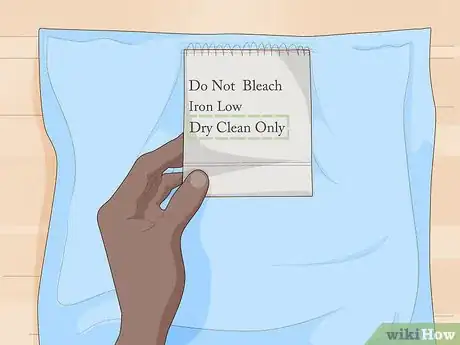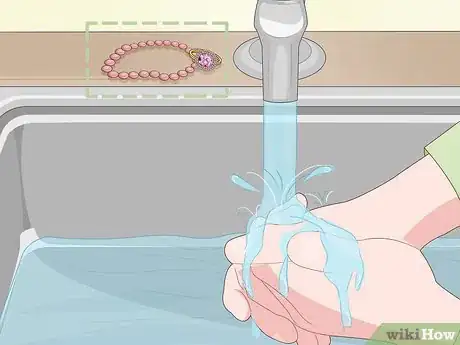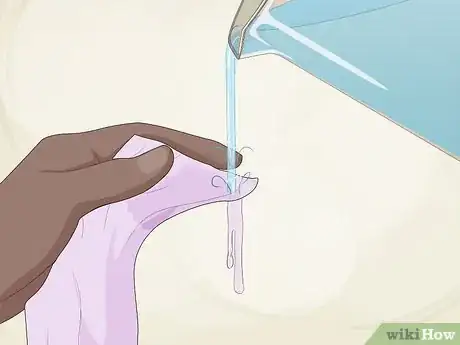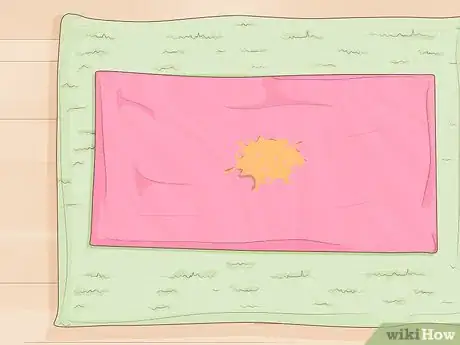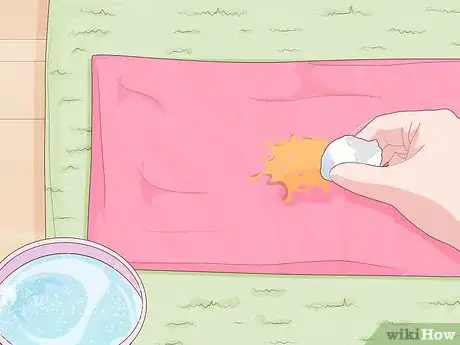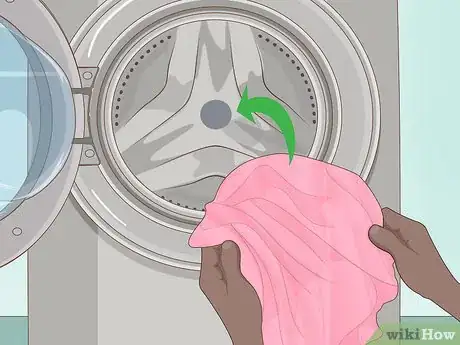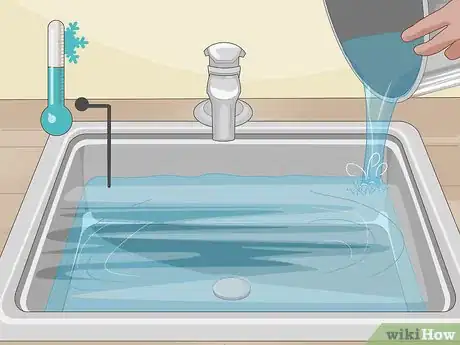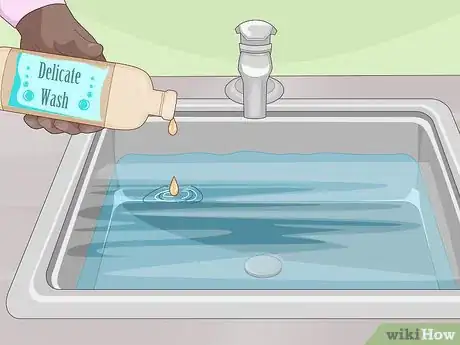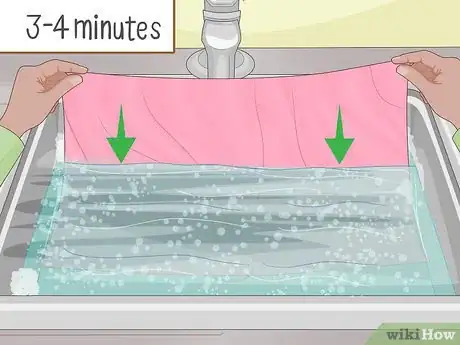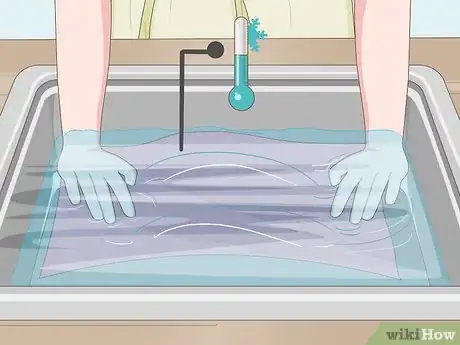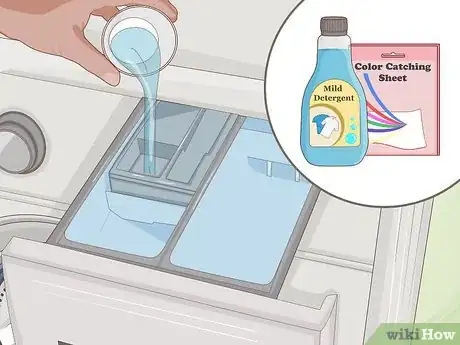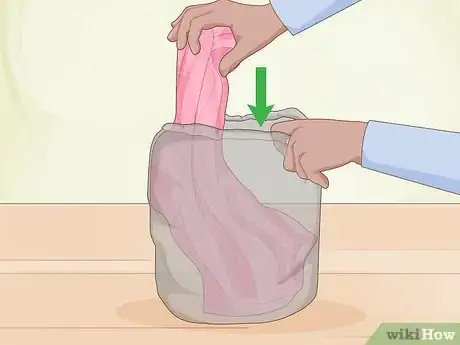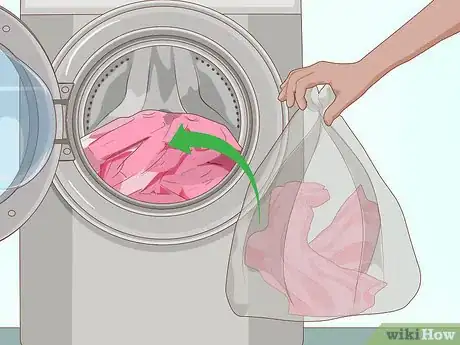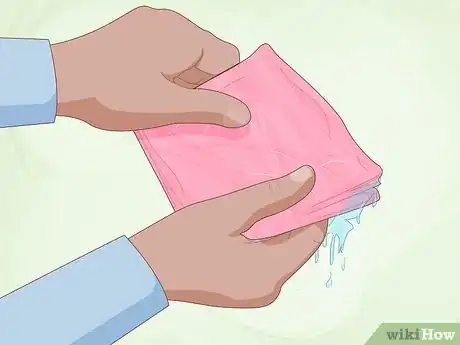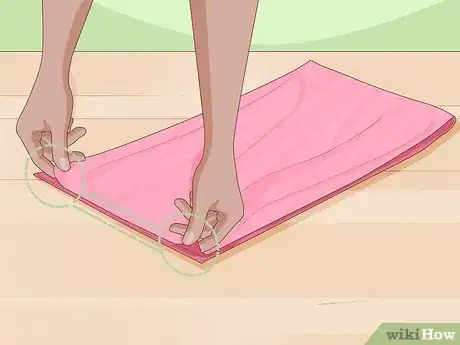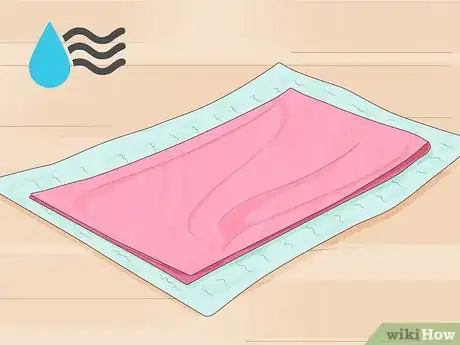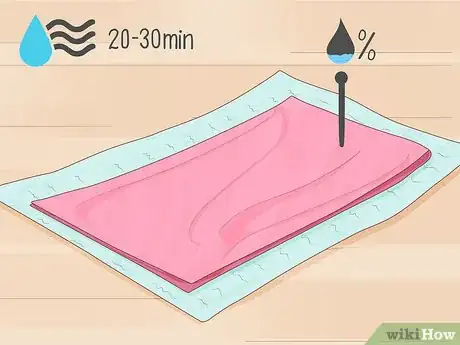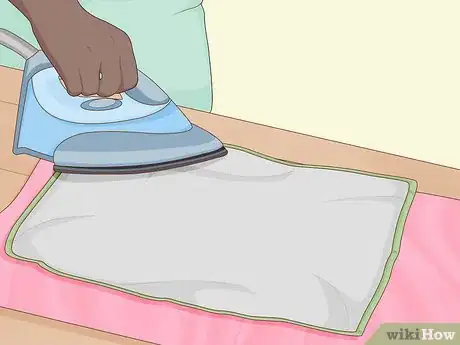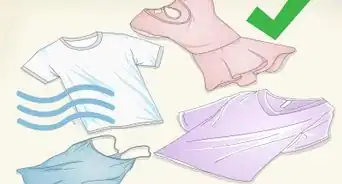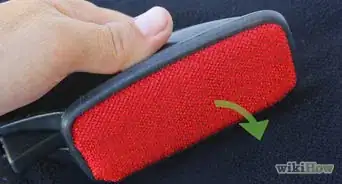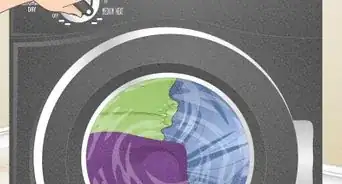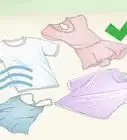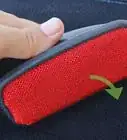This article was co-authored by Safir Ali. Safir Ali is the Co-Founder and CEO of Hamper Dry Cleaning and Laundry, a startup in Houston, Texas reinventing the laundry industry. With over six years of experience launching and operating Hamper, Safir specializes in innovative ways to simplify dry cleaning using the experience from his family's business. Safir holds a Bachelor’s degree in Business Administration and Management from Texas A&M University. Hamper offers 24/7 on-demand dry cleaning and laundry through delivery and kiosk services. Hamper has been featured on the Houston Rockets, Station Houston, the Houston Business Journal, BBVA, Yahoo Finance, and Innovation Map.
There are 8 references cited in this article, which can be found at the bottom of the page.
This article has been viewed 19,277 times.
Lustrous and brightly colored silk scarves sometimes need a little freshening up. Once you've confirmed the most suitable cleaning method for your silk scarf, you'll find that a basin of cool water and a splash of mild, silk-friendly detergent will work wonders. Always spot-test for colorfastness and be careful to protect your scarf from snagging and harmful cleaning chemicals. Once you gently dry and press your scarf, it'll look and feel as good as new!
Steps
Testing for Colorfastness Prior to Washing
-
1Examine the scarf's tag for cleaning instructions. You will typically find an icon or statement describing whether the item should be hand washed or if it may be machine washed. If it lists “Dry Clean” as the recommended method (rather than “Dry Clean Only”) avoid putting the piece through the harsh dry cleaning process. Instead, you should be able to gently hand wash it after a spot-test.[1]
- If your scarf is hand-painted, look at the maker's website or contact them to ask about preferred cleaning methods. The same can be done for scarves produced by luxury brands or designers.
- If the label reads “Dry Clean Only,” opt for the services of someone who has prior experience maintaining silk scarves like yours. If you have a luxury or vintage scarf, seek out a specialist.[2]
- Even if your scarf lists hand washing or machine laundering as acceptable maintenance procedures, you should still conduct a colorfastness test before the initial wash since some color may come out.
-
2Make sure your hands are clean and free of jewelry before handling the scarf. Wash your hands thoroughly to remove any oils and dirt that may transfer over to the silk. Additionally, you'll want to make sure there is nothing on your hands that could snag the delicate textile, especially if your scarf is a glossy but snag prone satin-weave. Remove all rings and bracelets, and buff down sharp corners of your fingernails with an emery board.[3]Advertisement
-
3Blot cool water onto an inconspicuous corner. Hold a cloth or paper towel behind this spot as you apply the water. You can splash on a few drops using a cup or dab the area with a saturated cotton ball. Here you'll be testing for colorfastness, which is the dye's resistance to running and fading. Most silk scarves, even hand-painted ones, are heat-set or finished in some other way to lock in the colors. But an initial test can confirm that yours is safe to clean.
- Use a light colored towel or cloth to do this. You'll be able to see any staining better, and will avoid transferring color from the towel to the scarf.
-
4Check for any color bleeding. Look to see if any color bled onto the towel. However, it's not unusual to see some initial bleeding during the first wash. Particularly dark or vibrant colors will tint the water during the washing process, but won't typically leave permanent stains on the rest of the silk.
- If you notice the colors visibly bleed into the water or leave pale marks on the towel during the spot test, you can drop a color catching sheet into the water along with the scarf, whether you hand- or machine-wash it. These sheets are designed to absorb loose dyes from the water, and can be purchased from the laundry aisle of a grocery or home goods store.[4]
- If you notice the water becomes heavily saturated with color or the darker dyes start transferring over into the lighter parts of the scarf, this amount of color bleeding is excessive. The dyes applied to your scarf may not have been set properly. You should refrain from applying any more water or detergent. Instead, consult a dry cleaner.
Spot Cleaning Minor Stains
-
1Place the scarf stain-side up on a clean, dry towel. The towel will soak up the excess moisture as you apply a cleaning solution to the stained spot. It's best to use a white or light-colored towel to prevent any color from transferring onto your scarf as well.
- Address the stain as soon as possible, since it will be harder to remove as time passes. Even if you're on the go and notice a small grease spot, you should immediately try blotting it out with mild hand soap and paper towels in a nearby restroom.[5]
-
2Prepare a cleaning solution of 1 part gentle detergent, 1 part water. For best results, use a detergent or stain remover that's specifically designed for use on delicate silk items. Mix a small amount with cool water to dilute the concentration.[6] Cool water won't irritate the scarf's fibers or dyes as much as hot water would.
- Refrain from using bleach and most other stain removing chemicals. If you're unsure about a particular product, spot test it in an unnoticeable area first.
-
3Dab the cleaning liquid onto the stain with a cotton swab. Soak the swab in the cleaning solution first. Place one hand beneath the towel to support the area you're cleaning, and gently massage the stain using the cotton swab. If the stain is oil- or water-based, it should quickly start to release from the fabric.[7]
-
4Hand or machine wash the entire scarf immediately. Cleaning only one spot with water and a cleaning solution can result in a slightly patchy appearance. Therefore, you should plan to submerge the entire scarf in water and a mild detergent and follow the full cleaning process to make sure your entire scarf ends up clean, fresh, and glossy![8]
- For instance, spot cleaning may result in a very minor change in the color, which may be noticeable if only restricted to one small spot.
-
5Enlist the help of a specialist for tough stains on luxury or vintage scarves. Large stained areas, serious pen blotches, and inexplicable discolored patches are best treated with caution. To avoid the frustration and possible heartbreak of a stubborn stain on a meaningful scarf, track down a dry cleaner who specializes in luxury goods or vintage clothing repair.
- It's worth contacting the cleaner to get a quote and make sure you understand the service and terms before handing your piece over. You may wish to consult reviews or ask for references as well to get a sense of how similar items have fared.
- Don't be shy about expanding your search to large metro areas, near or far. Some specialists accept shipments.[9]
Cleaning Silk Scarves by Hand
-
1Pour cool water into a clean sink or basin. Cool water will minimize the amount of color that's released into the water and will be gentler on the silk fibers. Fill the sink with just enough water to completely cover the scarf. Around 6 to 8 inches (15 to 20 cm) should be sufficient.
- The sink should be spotless. You may want to clean it a day or two ahead of time, to avoid putting your delicate scarf in contact with any other cleaning chemicals you may have used for the sink.[10]
-
2Add a few drops of a mild detergent. For best results, use a detergent that's specifically formulated for use on silk. You can also use gentle baby soap or very mild hand soap. Mix the soap into the water until it forms a froth.
- Products such as Delicate Wash by The Laundress or Le Blanc Silk and Lingerie Wash are designed to use when laundering delicate silks and help maintain your scarf's lustrous sheen.[11]
-
3Gently agitate the scarf in the water for 3 or 4 minutes. Rather than letting the scarf sit to soak for a long period of time, you'll want to constantly keep it moving in the soapy water. This will help release any dirt and grime from the fibers. Use your hands to delicately jostle around the scarf and keep it fully submerged under water.[12]
-
4Rinse the scarf in fresh cool water.[13] Remove the scarf from the sink and completely rinse away the suds and dirty water. Fill the sink up again (or use a separate one if you prefer) with clean, cool water. Gently agitate the scarf until all soap residue is gone.
- You can repeat the rinsing process as many times as necessary to remove all traces of detergent.[14]
Machine-Washing Silk Scarves
-
1Pour mild detergent into the washing machine. A gentle soap specifically intended for laundering silk items will provide the best results. However, you can also use mild baby detergent.
- If you noticed the scarf's colors bled a little during your spot test, add in a color catching sheet to the load.[15]
-
2Place the scarf in a mesh garment bag. This should protect the scarf from getting wrapped around the drum of your washing machine, and will also help keep it from getting tangled up with, or snagged by, other items. If you don't have a mesh bag, a knotted pillowcase can work as well.
-
3Add the scarf to a load of other delicate, similarly colored items. If your scarf is brightly colored, wash it along with other brightly colored delicates. If it's a creamy white color, it should be included in a load full of other white delicates. Avoid including bulky items like towels or sheets in the load. Don't include garments with metal zippers or hook closures, as these have the potential to snag your scarf.
-
4Run the load on a delicate cycle. You should adjust the settings to the gentlest possible spin and the shortest amount of time, to prevent soaking and agitating the scarf more than necessary. Use a cool water setting for the least amount of irritation to the fibers and dyes.
Drying and Pressing Scarves
-
1Fold and compress the scarf to gently squeeze out excess water. This is a particularly useful step if you hand-washed your scarf and it's fully saturated. Don't wring out and twist up the scarf or it will end up heavily wrinkled and misshapen. Instead, fold up the scarf into a little square packet and press it between both of your hands.[16]
-
2Roll up the scarf in a clean, dry towel to soak off any remaining moisture. Unfold the scarf and lay it flat atop a towel. It's best to use a white or light-colored towel that won't transfer any color onto your damp silk. Roll the towel up with the scarf inside it, and apply gentle pressure to squeeze out as much of the water as possible.[17]
-
3Line up the sides and corners to make sure the scarf maintains its shape. After you've washed and towel-dried the scarf, it might need a little adjusting to get back to its original dimensions. For a square scarf, match the corners together by folding the scarf into a perfect triangle. For a rectangular scarf, match up the corners by folding it in half once lengthwise and once crosswise. If any edges are out of alignment, you can carefully tug on the hemmed sides to ease them back to the right length while it's still slightly damp.[18]
-
4Let the scarf air dry on top of a towel. You can drape another clean, dry towel (or the same one, if it hasn't gotten too damp) over the top of a drying rack, a shower curtain rod, or even the back of a chair. Make sure it's a soft curve and that it won't create a hard crease in the middle of your scarf. Drape the scarf over the towel and gently smooth out wrinkles and creases with your hands.
- Avoid using clothespins or hangers with clips, as these will wrinkle and pinch the edges of the scarf.[19]
-
5Let the scarf dry for about 20 or 30 minutes. A lightweight silk scarf will be mostly dry after just a short period of time. You'll want the scarf to retain a very slight amount of moisture, though. This will help when you start pressing it. When the remaining moisture comes into contact with the iron's heat, it will quickly ease the creases out of the fabric.[20]
-
6Press the scarf gently using an iron and a protective press cloth. Place the scarf onto an ironing board and cover it with a press cloth, such as a plain white kitchen towel or a pillowcase. Adjust an iron to the silk setting and wait until it's fully heated up. Applying even pressure, smooth the iron over the press cloth until the creases have been eliminated from the scarf beneath.
- The ironing board and the surface of the iron itself should be clean before you bring them into contact with your freshly washed scarf.
- If your scarf has a hand-rolled hem, avoid running the iron over the edges. It's best to avoid flattening them out. When you see how beautifully your cleaned and pressed scarf drapes, you'll be glad you took extra care around these delicately finished edges.[21]
Expert Q&A
Did you know you can get expert answers for this article?
Unlock expert answers by supporting wikiHow
-
QuestionWhat is the best way to wash pure silk?
 Safir AliSafir Ali is the Co-Founder and CEO of Hamper Dry Cleaning and Laundry, a startup in Houston, Texas reinventing the laundry industry. With over six years of experience launching and operating Hamper, Safir specializes in innovative ways to simplify dry cleaning using the experience from his family's business. Safir holds a Bachelor’s degree in Business Administration and Management from Texas A&M University. Hamper offers 24/7 on-demand dry cleaning and laundry through delivery and kiosk services. Hamper has been featured on the Houston Rockets, Station Houston, the Houston Business Journal, BBVA, Yahoo Finance, and Innovation Map.
Safir AliSafir Ali is the Co-Founder and CEO of Hamper Dry Cleaning and Laundry, a startup in Houston, Texas reinventing the laundry industry. With over six years of experience launching and operating Hamper, Safir specializes in innovative ways to simplify dry cleaning using the experience from his family's business. Safir holds a Bachelor’s degree in Business Administration and Management from Texas A&M University. Hamper offers 24/7 on-demand dry cleaning and laundry through delivery and kiosk services. Hamper has been featured on the Houston Rockets, Station Houston, the Houston Business Journal, BBVA, Yahoo Finance, and Innovation Map.
Professional Dry Cleaner
-
QuestionHow can I get a stain out of a scarf made with 100% silk.
 Safir AliSafir Ali is the Co-Founder and CEO of Hamper Dry Cleaning and Laundry, a startup in Houston, Texas reinventing the laundry industry. With over six years of experience launching and operating Hamper, Safir specializes in innovative ways to simplify dry cleaning using the experience from his family's business. Safir holds a Bachelor’s degree in Business Administration and Management from Texas A&M University. Hamper offers 24/7 on-demand dry cleaning and laundry through delivery and kiosk services. Hamper has been featured on the Houston Rockets, Station Houston, the Houston Business Journal, BBVA, Yahoo Finance, and Innovation Map.
Safir AliSafir Ali is the Co-Founder and CEO of Hamper Dry Cleaning and Laundry, a startup in Houston, Texas reinventing the laundry industry. With over six years of experience launching and operating Hamper, Safir specializes in innovative ways to simplify dry cleaning using the experience from his family's business. Safir holds a Bachelor’s degree in Business Administration and Management from Texas A&M University. Hamper offers 24/7 on-demand dry cleaning and laundry through delivery and kiosk services. Hamper has been featured on the Houston Rockets, Station Houston, the Houston Business Journal, BBVA, Yahoo Finance, and Innovation Map.
Professional Dry Cleaner
-
QuestionCan I put a silk scarf in the dryer?
 Safir AliSafir Ali is the Co-Founder and CEO of Hamper Dry Cleaning and Laundry, a startup in Houston, Texas reinventing the laundry industry. With over six years of experience launching and operating Hamper, Safir specializes in innovative ways to simplify dry cleaning using the experience from his family's business. Safir holds a Bachelor’s degree in Business Administration and Management from Texas A&M University. Hamper offers 24/7 on-demand dry cleaning and laundry through delivery and kiosk services. Hamper has been featured on the Houston Rockets, Station Houston, the Houston Business Journal, BBVA, Yahoo Finance, and Innovation Map.
Safir AliSafir Ali is the Co-Founder and CEO of Hamper Dry Cleaning and Laundry, a startup in Houston, Texas reinventing the laundry industry. With over six years of experience launching and operating Hamper, Safir specializes in innovative ways to simplify dry cleaning using the experience from his family's business. Safir holds a Bachelor’s degree in Business Administration and Management from Texas A&M University. Hamper offers 24/7 on-demand dry cleaning and laundry through delivery and kiosk services. Hamper has been featured on the Houston Rockets, Station Houston, the Houston Business Journal, BBVA, Yahoo Finance, and Innovation Map.
Professional Dry Cleaner
Warnings
- Never use a digestive cleaner or enzyme cleaner on silk scarves. The enzymes in these detergents, while good at eating away protein-based stains, will eat away the silk proteins themselves![25]⧼thumbs_response⧽
- Avoid using bleach. It will not only be harsh on the silk fibers but will be especially damaging to colorfully printed or hand-painted scarves.[26]⧼thumbs_response⧽
References
- ↑ http://www.howtocleanstuff.net/how-to-wash-silk/
- ↑ http://www.maitaispicturebook.com/2017/04/how-to-clean-wash-and-care-for-your.html
- ↑ http://www.maitaispicturebook.com/2017/04/how-to-clean-wash-and-care-for-your.html
- ↑ http://www.maitaispicturebook.com/2017/04/how-to-clean-wash-and-care-for-your.html
- ↑ https://lalouettesilk.com/blog/complete-guide-to-silk-care/
- ↑ http://www.maitaispicturebook.com/2017/04/how-to-clean-wash-and-care-for-your.html
- ↑ http://www.maitaispicturebook.com/2017/04/how-to-clean-wash-and-care-for-your.html
- ↑ https://www.thelaundress.com/clean-talk-blog/content/how-to-wash-silk.html
- ↑ https://betweennapsontheporch.net/washing-an-hermes-silk-scarf-madame-paulette/
- ↑ http://www.maitaispicturebook.com/2017/04/how-to-clean-wash-and-care-for-your.html
- ↑ http://www.maitaispicturebook.com/2017/04/how-to-clean-wash-and-care-for-your.html
- ↑ http://www.maitaispicturebook.com/2017/04/how-to-clean-wash-and-care-for-your.html
- ↑ Safir Ali. Professional Dry Cleaner. Expert Interview. 15 September 2020.
- ↑ http://www.howtocleanstuff.net/how-to-wash-silk/
- ↑ http://www.maitaispicturebook.com/2017/04/how-to-clean-wash-and-care-for-your.html
- ↑ http://www.maitaispicturebook.com/2017/04/how-to-clean-wash-and-care-for-your.html
- ↑ http://www.howtocleanstuff.net/how-to-wash-silk/
- ↑ http://www.maitaispicturebook.com/2017/04/how-to-clean-wash-and-care-for-your.html
- ↑ http://www.maitaispicturebook.com/2017/04/how-to-clean-wash-and-care-for-your.html
- ↑ http://www.maitaispicturebook.com/2017/04/how-to-clean-wash-and-care-for-your.html
- ↑ http://www.maitaispicturebook.com/2017/04/how-to-clean-wash-and-care-for-your.html
- ↑ https://www.realsimple.com/home-organizing/cleaning/laundry/do-i-have-to-dry-clean-this
- ↑ http://www.maitaispicturebook.com/2017/04/how-to-clean-wash-and-care-for-your.html
- ↑ http://www.maitaispicturebook.com/2017/04/how-to-clean-wash-and-care-for-your.html
- ↑ https://www.marthastewart.com/265555/removing-stains-the-basics
- ↑ https://www.marthastewart.com/265555/removing-stains-the-basics
